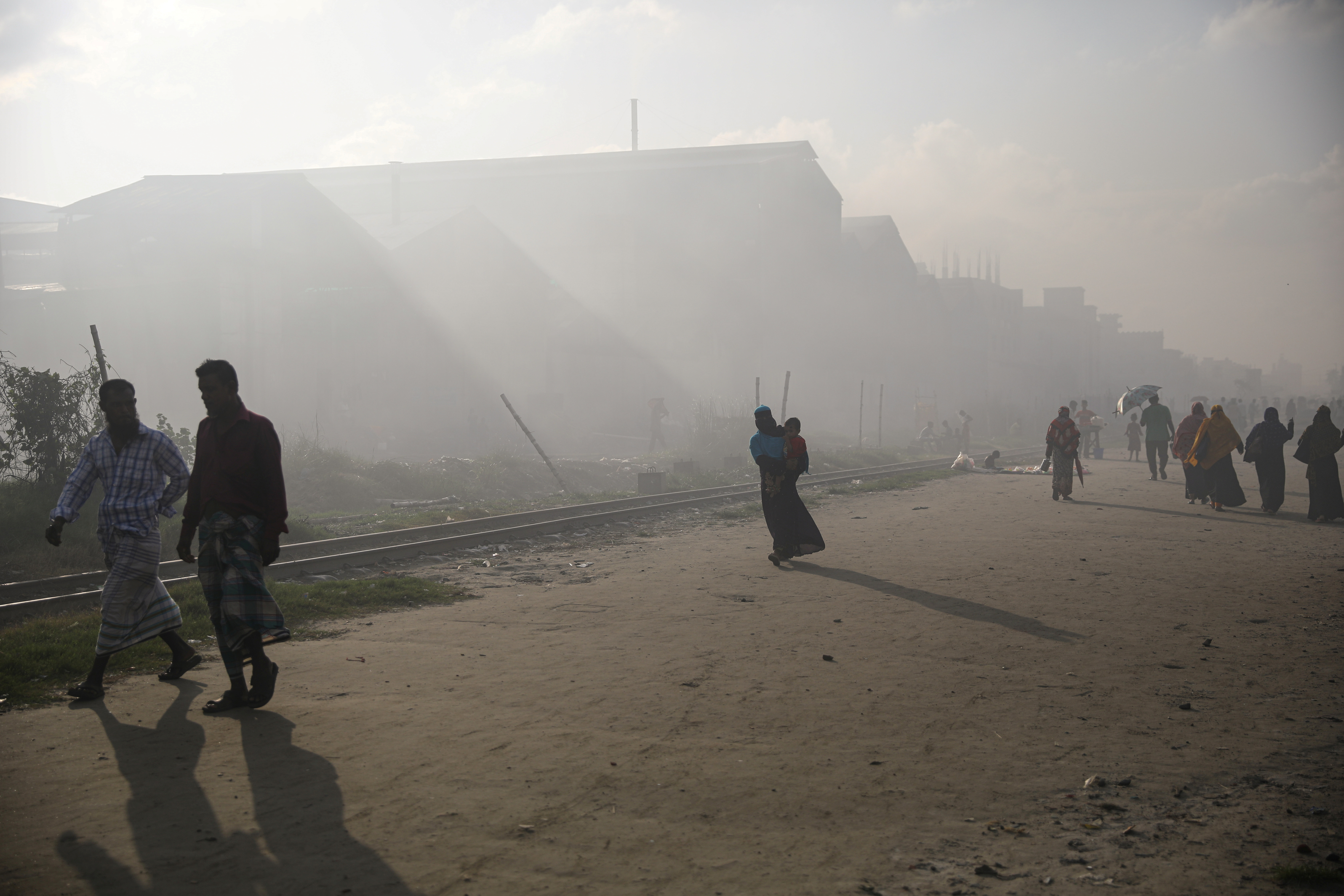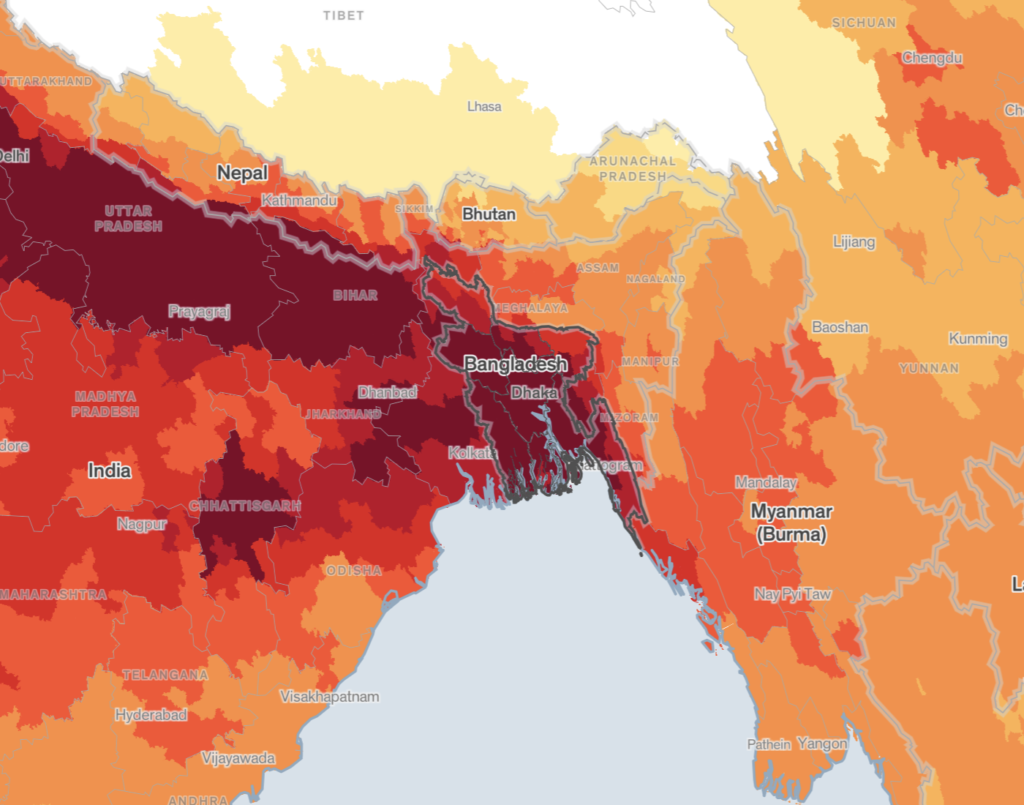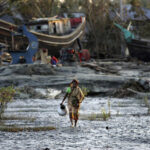Air pollution in Bangladesh is a significant issue, resulting from a high number of vehicles on the roads emitting exhaust fumes, as well as pollution from factories, brick kilns, and dust. This pollution has detrimental effects on both the environment and the health of the population.
The country’s air quality index (AQI) consistently ranks among the worst in the world. The pollution crisis in Bangladesh has severe consequences for public health, the economy, and the overall well-being of its citizens. It is crucial to address and mitigate this problem to ensure a greener future and improve the quality of life for the people of Bangladesh.

Credit: www.bloomberg.com
The Silent Crisis: Air Pollution In Bangladesh
The Alarming State Of Air Quality
Bangladesh is grappling with a severe air pollution crisis, with its capital city, Dhaka, consistently ranking among the most polluted cities in the world. The air quality index (AQI) often reaches hazardous levels, posing significant health risks to the population. The alarming state of air quality in Bangladesh is a pressing concern that demands urgent attention and action.
Historical Context Of Pollution Levels
The issue of air pollution in Bangladesh has historical roots, with rapid industrialization and urbanization contributing to the escalation of pollution levels. Vehicular emissions, industrial activities, and the widespread use of biomass for cooking are key factors driving the deterioration of air quality. Over the years, these trends have led to a significant decline in the overall air quality, impacting the health and well-being of the population.

Credit: www.bloomberg.com
Sources Of Air Contamination
Air pollution in Bangladesh is primarily caused by various sources, including vehicular emissions, industrial discharge, and urban dust. These sources contribute to the deteriorating air quality in the country, posing significant health and environmental risks.
Vehicular Emissions: The Main Culprit
Vehicular emissions are the leading cause of air pollution in Bangladesh. The extensive use of cars, motorbikes, buses, and trucks on the roads results in the release of substantial amounts of exhaust fumes containing harmful pollutants such as carbon monoxide, nitrogen oxides, and particulate matter. The high volume of vehicular traffic in urban areas further exacerbates this issue, significantly impacting air quality.
Industrial Discharge And Urban Dust
Industrial discharge is another significant contributor to air contamination in Bangladesh. Factories and brick kilns release a variety of pollutants into the atmosphere, including sulfur dioxide, volatile organic compounds, and heavy metals. These emissions not only degrade air quality but also have detrimental effects on public health and the environment.
In addition to industrial discharge, urban dust plays a notable role in exacerbating air pollution. Construction activities, unpaved roads, and urban development contribute to the generation of particulate matter, which becomes suspended in the air, leading to increased levels of pollution in urban areas.
Health Impacts On The Population
Air pollution in Bangladesh has severe health impacts on the population, leading to respiratory illnesses and shortened life expectancy. Vehicular emissions, fumes from factories, and dust contribute to the high pollution levels, posing significant health risks for the people of Bangladesh.
The situation calls for urgent measures to address and mitigate the health effects of air pollution.
Respiratory Illnesses On The Rise
Air pollution is a major concern in Bangladesh, with vehicular emissions, fumes from factories and brick kilns, and dust contributing to the high levels of pollution in the country. The impact of air pollution on the health of the population is significant, with respiratory illnesses on the rise. According to the World Bank, respiratory diseases are among the top ten causes of death in Bangladesh, and air pollution is a significant contributor to this trend. The high level of air pollution has led to an increase in the number of people suffering from respiratory illnesses, including asthma, bronchitis, and chronic obstructive pulmonary disease (COPD). The situation is particularly dire in cities like Dhaka, where air pollution levels often exceed safe limits. In recent years, there has been a sharp rise in the number of people seeking medical attention for respiratory illnesses, and this trend is expected to continue unless concrete steps are taken to address air pollution.Decreasing Life Expectancy
The impact of air pollution on the health of the population in Bangladesh is not limited to respiratory illnesses. Air pollution is also shortening the life expectancy of people in the country. A study conducted by the World Bank found that exposure to high levels of air pollution is reducing life expectancy by an average of 1.3 years in Bangladesh. The situation is particularly dire for vulnerable populations like children and the elderly. Children who are exposed to high levels of air pollution are at risk of developing chronic respiratory illnesses that can impact their long-term health and well-being. Similarly, the elderly are at risk of developing cardiovascular disease and other health issues due to exposure to air pollution. In conclusion, air pollution in Bangladesh is having a significant impact on the health of the population. Respiratory illnesses are on the rise, and life expectancy is decreasing due to exposure to high levels of pollution. Urgent action is needed to address this issue, including measures to reduce emissions from vehicles and factories, as well as promoting the use of clean energy sources. Only by taking concrete steps to address air pollution can we hope to improve the health and well-being of the people of Bangladesh.
Credit: www.reuters.com
Economic Consequences Of Air Pollution
Air pollution in Bangladesh not only poses a severe threat to public health and the environment but also carries significant economic consequences. The detrimental effects of air pollution can be observed in the soaring healthcare costs and the impact it has on workforce productivity.
Healthcare Costs Soar
The poor air quality in Bangladesh has led to a surge in respiratory illnesses and other health complications, resulting in a substantial increase in healthcare costs. Individuals exposed to polluted air are more susceptible to respiratory infections, asthma, and other chronic diseases. These medical conditions require extensive healthcare services, including hospital visits, medications, and specialized treatments, placing a burden on the healthcare system.
Impact On Workforce Productivity
The adverse effects of air pollution extend beyond healthcare costs and also have a profound impact on workforce productivity. Employees exposed to polluted air often experience decreased lung function, respiratory symptoms, and increased absenteeism due to illness. This leads to a decline in overall productivity, as workers may struggle to perform at their full potential or may be forced to take time off work to recover from pollution-related health issues.
Moreover, the reduced productivity of the workforce can have ripple effects on the economy as a whole. Industries may experience delays in production, decreased efficiency, and increased expenses due to the need for additional measures to mitigate the impact of air pollution on workers.
Overall, the economic consequences of air pollution in Bangladesh are significant. The soaring healthcare costs and the decline in workforce productivity highlight the urgent need for effective measures to address air pollution and improve the quality of life for the population.
Environmental Degradation
Air pollution in Bangladesh is a pressing issue, with vehicular emissions, factory fumes, and dust contributing to deteriorating air quality. The high levels of pollution are causing adverse health effects and impacting the environment. Effective measures are urgently needed to address this critical problem.
Effects On Flora And Fauna
Environmental degradation caused by air pollution in Bangladesh has significant effects on flora and fauna. Plants and trees are exposed to high levels of pollutants, which can cause reduced growth and productivity. The toxic chemicals emitted from factories and brick kilns can also lead to soil contamination, making it difficult for plants to absorb nutrients and water. Similarly, air pollution also affects the reproductive processes of animals and birds, leading to a decline in their population. The contamination of water bodies due to air pollution can also be harmful to aquatic life, leading to the death of fish and other water organisms.The Urban Heat Island Effect In Dhaka
The Urban Heat Island (UHI) effect is a phenomenon where the temperature in urban areas is higher than the surrounding rural areas. Dhaka, the capital city of Bangladesh, is one of the worst affected by the UHI effect. The high concentration of vehicles, industries, and buildings in the city leads to the trapping of heat, causing an increase in temperature. The UHI effect can also lead to the formation of smog, which can cause respiratory problems, especially for people with pre-existing conditions like asthma. The UHI effect also has economic implications as it increases the energy consumption for cooling purposes, leading to higher electricity bills. In conclusion, air pollution in Bangladesh has severe consequences on the environment, human health, and the economy. The effects on flora and fauna and the UHI effect in Dhaka are just a few examples of the impact of air pollution. It is crucial for the government and citizens to take steps to reduce air pollution and protect the environment.Policy Responses And Future Strategies
In response to air pollution in Bangladesh, policy responses and future strategies are being developed to address vehicular emissions, factory fumes, and dust. Initiatives to reduce pollution from cars, motorbikes, buses, and trucks are being implemented to improve air quality and public health.
Efforts to mitigate the impact of air pollution on the environment and human health are crucial for a sustainable future in Bangladesh.
Policy Responses and Future Strategies Bangladesh is one of the most heavily polluted countries in the world, with air pollution being a major contributor to the country’s environmental problems. The government of Bangladesh has recognized the severity of this issue and has taken several initiatives to mitigate air pollution. In this section, we will discuss the policy responses and future strategies of the government to combat air pollution in Bangladesh. Government Initiatives The government of Bangladesh has launched several initiatives to tackle air pollution in the country. Some of the notable initiatives are: – The Bangladesh Environment Conservation Act, which was enacted in 1995, provides a legal framework for environmental protection in the country. – The National Clean Air Action Plan (NCAP), which was launched in 2019, aims to reduce air pollution levels by 50% by 2030. – The government has also imposed strict regulations on industries to reduce their emissions and has banned the use of two-stroke engines in vehicles. – The introduction of compressed natural gas (CNG) as an alternative to gasoline has also helped to reduce emissions from vehicles. Vision for a Greener Future The government of Bangladesh has a vision for a greener and cleaner future. The vision includes: – Increasing the use of renewable energy sources such as solar, wind, and hydro power. – Promoting green transportation through the use of electric vehicles and bicycles. – Encouraging the use of public transportation and reducing the number of private vehicles on the road. – Creating green spaces in urban areas to improve air quality and reduce the urban heat island effect. Future Strategies The government of Bangladesh has outlined several future strategies to tackle air pollution in the country. Some of the strategies are: – Strengthening the enforcement of existing regulations and introducing new regulations to reduce emissions from industries and vehicles. – Increasing public awareness about the harmful effects of air pollution and promoting behavior change to reduce emissions. – Improving the monitoring and reporting of air quality data to inform policy decisions. – Strengthening international cooperation to address transboundary air pollution issues. In conclusion, the government of Bangladesh has taken several initiatives to combat air pollution in the country. The vision for a greener future and the future strategies outlined by the government provide a roadmap for a cleaner and healthier Bangladesh. It is essential that these initiatives are implemented effectively and efficiently to ensure a sustainable future for the country.Community And Global Efforts
Air pollution in Bangladesh is a pressing issue that affects the health and well-being of its citizens. Recognizing the severity of the problem, both local communities and global organizations have been actively working towards finding solutions and implementing measures to combat air pollution.
Local Actions For Clean Air
At the local level, various initiatives have been taken to improve air quality and promote clean air practices. These include:
- Implementation of stricter emission standards for vehicles
- Promotion of public transportation and cycling as alternatives to private vehicles
- Encouragement of tree plantation and green spaces to absorb pollutants
- Establishment of air quality monitoring stations to track pollution levels
- Education and awareness campaigns to inform the public about the impacts of air pollution
These local actions not only aim to reduce pollution levels but also empower communities to take ownership of their environment and make sustainable choices.
International Support And Collaboration
The fight against air pollution in Bangladesh has also garnered international attention and support. Global organizations and collaborations have been instrumental in providing assistance and expertise in tackling the issue. Some key initiatives include:
- Technical support and funding from international agencies such as the World Bank
- Knowledge-sharing and capacity-building programs with foreign experts
- Collaborative research projects to understand the specific challenges faced by Bangladesh
- Advocacy for policy changes and implementation of international best practices
These international efforts not only bring valuable resources but also foster partnerships that enable knowledge exchange and innovation in combating air pollution.
In conclusion, addressing air pollution in Bangladesh requires a collective effort from both local communities and global organizations. By implementing local actions for clean air and fostering international support and collaboration, we can work towards a healthier and cleaner environment for present and future generations.
Navigating Towards A Solution
Air pollution in Bangladesh is a pressing issue, with vehicular emissions, factory fumes, and dust contributing to the problem. The country’s air quality index is among the worst in the world, causing health risks and impacting the economy. Addressing this environmental pollution is crucial for a greener and healthier future in Bangladesh.
Navigating Towards a Solution Air pollution is a significant problem in Bangladesh, with vehicular emissions, fumes from factories and brick kilns, and dust contributing to the poor air quality. However, there are innovative technologies for monitoring, public awareness and education initiatives, and other strategies that can help mitigate this issue. Innovative Technologies for Monitoring One way to combat air pollution in Bangladesh is through innovative technologies for monitoring. For instance, the Bangladesh Air Quality Index (AQI) provides real-time information about the air quality in different parts of the country. This information can be used to alert people to areas where the air quality is poor and encourage them to take precautions, such as wearing masks or avoiding outdoor activities. Another technology that can help monitor air pollution is satellite imagery. This technology can be used to track the sources of pollution and to identify areas where the air quality is the worst. This information can then be used to develop targeted strategies for reducing pollution in those areas. Public Awareness and Education Another critical component of addressing air pollution in Bangladesh is through public awareness and education initiatives. By educating people about the dangers of air pollution and how they can protect themselves, we can encourage people to take steps to reduce their exposure to pollution. One way to raise awareness about air pollution is through public service announcements. These can be shown on television or shared on social media to reach a wide audience. Additionally, schools and community organizations can host events to educate people about air pollution and how to protect themselves. Other Strategies In addition to innovative technologies for monitoring and public awareness and education initiatives, there are other strategies that can help combat air pollution in Bangladesh. For example, the government can implement regulations and policies to reduce pollution from factories and other sources. Additionally, individuals can take steps to reduce their carbon footprint, such as using public transportation or walking instead of driving. Conclusion While air pollution is a significant problem in Bangladesh, there are strategies that can help mitigate this issue. By implementing innovative technologies for monitoring, public awareness and education initiatives, and other strategies, we can work towards reducing air pollution and improving the health of people in Bangladesh.Frequently Asked Questions
What Causes Air Pollution In Bangladesh?
The main causes of air pollution in Bangladesh are vehicular emissions from cars, motorbikes, buses, and trucks, as well as fumes from factories and brick kilns, and dust. The high number of vehicles on the roads contribute to the emission of exhaust fumes, leading to significant pollution levels in the country.
How Bad Is The Air Quality In Bangladesh?
The air quality in Bangladesh is extremely bad due to high levels of pollution caused by vehicles, factories, and dust. This pollution has severe impacts on the health of the population and the environment. Measures need to be taken to address this issue and improve the air quality in Bangladesh.
When Did Bangladesh Become So Polluted?
Bangladesh has been facing severe pollution for quite some time now. The main causes of pollution in the country are vehicular emissions, fumes from factories and brick kilns, as well as dust. With a high number of vehicles on the roads emitting exhaust fumes, the pollution levels have risen significantly.
This pollution has had detrimental effects on the lives of people and the environment.
What Are The Diseases Caused By Air Pollution In Bangladesh?
Air pollution in Bangladesh can cause respiratory illnesses and shorten life expectancy due to high pollution levels.
Conclusion
Air pollution in Bangladesh is a pressing issue that poses significant threats to both human health and the environment. The main causes of pollution in the country are vehicular emissions, fumes from factories and brick kilns, as well as dust.
These pollutants have detrimental effects on the population, leading to respiratory illnesses and a reduction in life expectancy. It is crucial for the government and stakeholders to take immediate action to address this problem and implement effective measures to improve air quality for a healthier and sustainable future.


